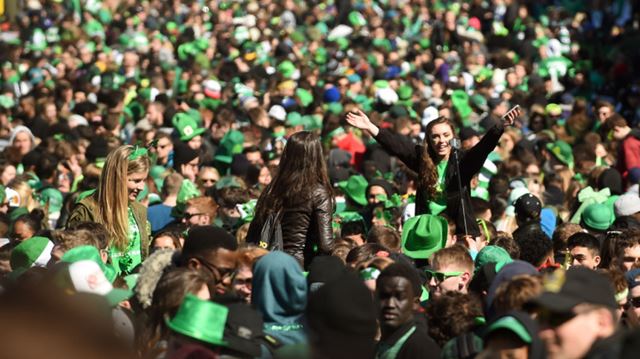WATERLOO REGION — The St. Patrick's Day bash held on Ezra Avenue in Waterloo which attracts more than 7,000 students has potential to turn into a "major event we will regret," said police board chair Tom Galloway.
"This board is seriously concerned," Galloway said at a police board meeting Wednesday.
Deputy Chief Kevin Thaler presented a report on the event, describing it as a success from a police monitoring perspective. But with the annual party becoming bigger each year, the celebration could reach a tipping point.
"We are one event away from a potential emergency," said Thaler, referring to the thousands of students that congregate on Ezra. A licensed tent on Seagram Drive attracted about 3,500 partygoers.
Thaler said a video online by an American university suggests Waterloo has the best St. Patrick's Day party in Canada.
However, Thaler commended the police and its partners, including fire, emergency medical services, the universities and the City of Waterloo, for making the event as safe as possible.
"It was a team effort," he said.
Only four arrests were made but police handed out 269 tickets, most of them related to open alcohol. A total of 23 charges were laid for underage drinking.
City of Waterloo bylaw department responded to 35 incidents, including parking lot enforcement and public nuisance calls.
Emergency services attended to 37 calls and sent eight people to hospital.
Although police spent $100,000 to cover staff for the event, the only additional monies to the 2015 budget were $3,200 for overtime costs, said Police Chief Bryan Larkin.
Galloway said he wasn't as concerned about resources and costs because the money would be spent on staff elsewhere in the region.
"We have a responsibility to police events like this. We can't say we won't. That's ludicrous," he said.
But Galloway said he's concerned that the party is growing each year with busloads of revelers coming from other universities.
"We can't sustain the growth of this as a police service," he said.
"When it goes sideways and a tragedy occurs, police will be blamed for not doing enough."
Galloway said he wouldn't want to see a repeat of what took place in London, Ont., in 2012, when St. Patrick's Day parties grew out of control and people threw rocks, bottles and debris at police and firefighters.
"We are one bottle thrown from a major problem," he said.
"I don't have answers but I'm really concerned," Galloway added.
Around the board table, members asked police if the event could be curtailed or controlled by stopping a large number of students from gathering on the street.
"We can't say, 'You can't come here,' " said Deputy Chief Kevin Chalk, referring to gatherings on a public street or the front lawns of residences.
"It's a heavy-handed approach and a non-starter," he said. "The reality is there is no mechanism to stop it. It's an organic function that happens, like homecoming."
Larkin said he would like to see a larger discussion from a philosophical point of view, involving community leaders such as university presidents, the city's chief administrative officer and regional public health.
"Let's reach out to those with influence and see what they are thinking," Larkin said in an interview after the meeting.
Larkin said he's more concerned with the binge drinking and the 37 medical calls required that day.
Hanging out on a front lawn is lawful, he said.
"This illusion that this was Mardi Gras, I don't accept," Larkin said.







